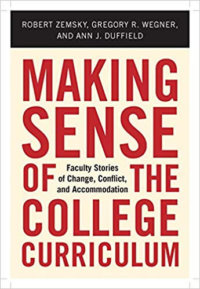Making Sense of The College Curriculum: Faculty Stories of Change, Conflict, and Accommodation

Making Sense of The College Curriculum: Faculty Stories of Change, Conflict, and Accommodation. Robert Zemsky, Gregory R. Wegner, and Ann J. Duffield. New Brunswick: Rutgers University Press, 2018.
In 1985, the Association of American Colleges (AAC) released Integrity in the College Curriculum, which criticized the undergraduate degree where grades have gone up, scholastic aptitude tests have gone down, and business employers complain that college students are barely literate. The college curriculum itself was singled out for criticism where the absence of a rationale is evident with messages of “pick eight of the following.” The curriculum is nothing more than a supermarket where students are shoppers and professors are merchants.
Twenty years later Derek Bok’s Our Underachieving Colleges tells much the same tale Integrity had told: too much unconstrained student choice, too little understanding of what students ought to be learning and the skills acquiring, too much acquiescence in faculty culture that fits faculty interests but not student needs. What is needed is reform which must begin at the college curriculum with faculty needing to take responsibility for it. It is only then when the problems of escalating costs and low student success can be resolved. When the college curriculum is coherent and serves student needs, then costs will drop and success will rise.
Making Sense of The College Curriculum is a collection of stories by faculty from a range of institutions about their profession and illuminates why it is difficult for universities to develop a coherent curriculum. Their stories belie the notion that faculty care more about their scholarship than students and work as much, if not more, than other professionals. Instead of reviewing each professor’s story, I will highlight some of the issues in developing a coherent college curriculum.
Common obstacles are distrust between faculty and administration; fixation on details rather than the bigger picture; the merging of different academic programs into one unit; a fragmented general education curriculum; an outmoded curriculum for a globalized world; teaching a nontraditional student body; and disgruntled faculty.
Some best practices identified are to establish policies and practices where people are talking about the same subject rather than past each other; discovering ways to collaborate with other academic programs; re-imagine general education as introductory paths to select majors and update it to incorporate new forms of knowledge; and innovative teaching practices, like experiential learning.
Underlying these faculty stories was the importance of teaching and how it has to be reinvented for an ever-changing educational landscape. This is particularly relevant in today online learning environment. Another theme that emerges is that while pedagogical change is an exercise in addition, curriculum change is always an exercise in subtraction.
The authors conclude with the following practical advice for curriculum reform. Over the summer and first semester, appoint a faculty coordinating committee to examine the curriculum; convene an all-faculty conversation about it; convene faculty work groups that focus on processes, procedures, and organizational arrangements to be reviewed by the coordinating committee. In the second semester, convene a second all-faculty conversation about curriculum proposals with faculty work groups reviewing and commenting on them. After this, convene a third faculty conversation about the formal process for change with work groups recommending specific proposals. The coordinating committee uses the work groups’ proposals to develop a final plan that is reviewed by a fourth all-faculty gathering.
Making Sense of The College Curriculum is a useful start about how to make a coherent college curriculum. While the faculty stories were interesting, most were not integrated into the overarching theme of curriculum reform, giving the book a disjointed feel. But perhaps that is fitting, for today’s college curriculum likewise is fragmented and mumbled. How we can get out of it continues to be an elusive goal for many universities, leaving both faculty and students adrift and lost.




